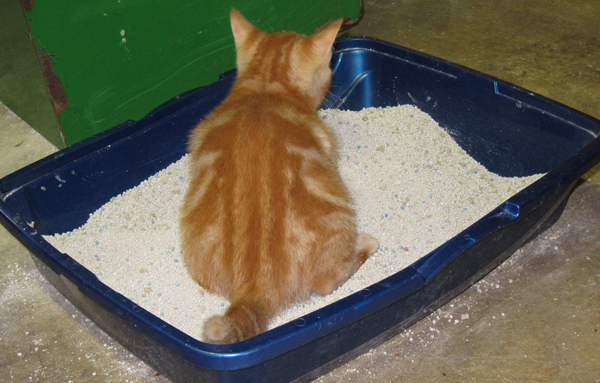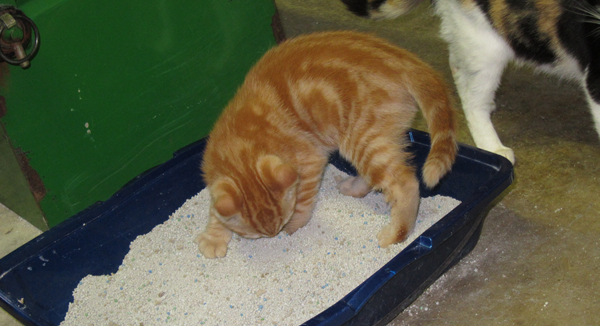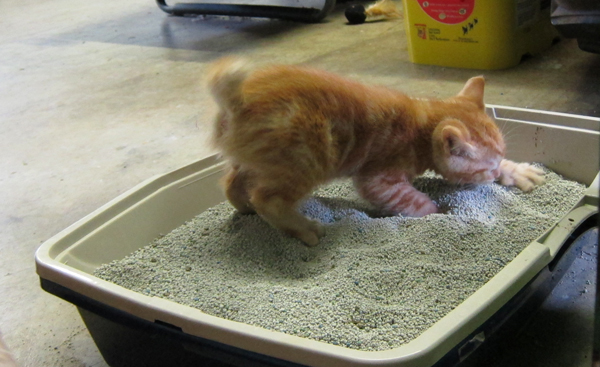
Litter Boxes, a Cat’s Perspective
Admit it – you love your cat, but you hate his litter box. As an unpaid representative of the feline nation, I’m not asking you to love the litter box, but at least try to view it from your cat’s perspective. Below I discuss five aspects of the litter box that are important to your cat, and one aspect that should be important to you.

#1 Location, location, location
Just like real estate, location is a big factor. Would you want your house located on a busy street? Not if you have a choice. More importantly, would you want a parade of foot traffic going by when you’re sitting on the throne? Definitely not. Cats feel the same way. Ideally you want to locate the litter box in a private area that is easily accessible for your cat and for you, since you’ll be doing the cleaning (see Maintenance below). And please do NOT locate the box by the feeding area (do you eat in your bathroom?).
#2 Size
The bigger the box, the better (imagine your toilet scaled down by 50%… doesn’t give you much of a landing pad, does it?). Cats don’t need a box that’s the size of a pool table, but something bigger than a postage stamp is a must. Your cat needs room to move around and dig. My people use Sterilite 28 Quart Clear Storage Boxes (without the lids, obviously). They are great – purrfect footprint size, just the right depth, and a great price.
#3 Number
There is a simple law called the “Litter Box Quantity Law” that you must not violate:
Number of litter boxes = number of cats + 1
For example, in my house there are two cats (me and Dré). Therefore, there are 3 boxes (2 + 1 = 3). Really simple, even for the mathematically challenged. You might be asking, why is it so important to follow this litter box quantity law? Well, expecting cats to share one litter box is like expecting your teenagers to share a bathroom without fighting. Think of your cats as teenagers with fur and claws. The more boxes there are, the less chance a usage conflict will arise.
#4 Litter
Once you find a brand and litter type that your cat likes, do not suddenly change it on him. Think of litter like a personal care product – shampoo, deodorant, toilet paper, etc. – most people have their favorite brands and don’t like to just use the cheapest product off the shelf. Cats feel the same way. Personally I recommend Tidy Cats 24/7 Clumping litter. It has great odor control and my people tell me it’s easy to scoop (plus when they’re empty the buckets are great for yardwork waste and for washing your car).
#5 Maintenance (MOST important)
Maintaining the litter box is one of your most important responsibilities. Some people don’t scoop their cats’ boxes for days (once a week?!?!), then they wonder why their cat is avoiding the litter box. Would you go a day or more without flushing your toilet? If the thought of that makes you cringe, then you can imagine how your cat feels when he steps into a dirty box. It’s not that hard to keep the box clean and ready to use when your cat needs it. Near the box set up the following: A small plastic bucket to keep the scoop in, a receptacle with plastic bags for the waste, a broom and dust pan to sweep up litter, or a small hand vac. If the flooring is not carpeted, put a small area rug near the entrance/exit of the box, so your cat can get a lot of the litter off of his feet when he leaves the box. Check the box a few times a day, and if your cat has used it, scoop it right away. Bonus tip from my people: after you scoop the box, put in “X” in the litter surface, that way you can quickly glance at the box from afar and easily determine if it needs scooping.
A Diagnostic tool (or how you can use the litter box without actually getting in it!)
Last but not least, the litter box is a great way for you to keep tabs on your cat’s health. Cats are the original stoics, experts at hiding illnesses. It’s part of our self-preservation instinct. People often don’t realize they need to take their cat to the doctor until he is really sick. This is where the litter box can be used as an important diagnostic tool. If you consistently scoop the box, you’ll have an idea of how often and how much your cat “goes.” Red flags will immediately pop up in your head if your cat is urinating a lot more or less, or if he has diarrhea or is constipated. This is the number one reason you should not invest in a litter box that “automatically” cleans itself – you’ll be depriving yourself of a vital monitoring tool that will help you nip potential health problems in the bud.
Conclusion
So that’s a cat’s take on the litter box. Keep it private, keep it roomy, and keep it clean. And if you have more than one cat, obey the Litter Box Quantity Law. If you have any additional tips, feel free to leave a comment and let me know. I’ll respond in between cat naps!

